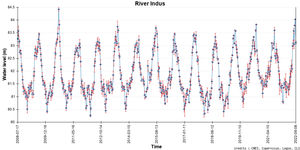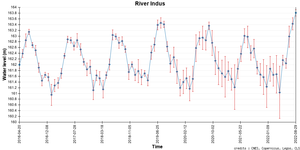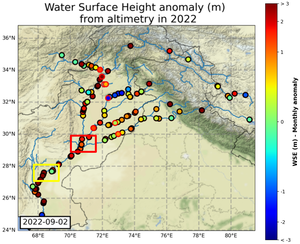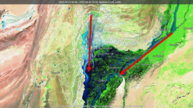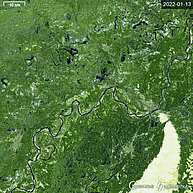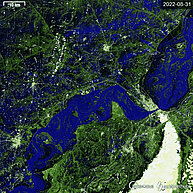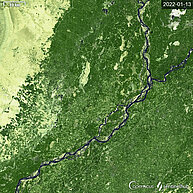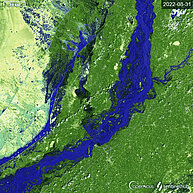Floods in Pakistan
2022 summer extreme events
One-third of Pakistan has been flooded during the summer of 2022, much more than the usual monsoon flooding.
A very hot spring, with temperatures reaching 51°C may have worsened the monsoon rains, since hot air can hold more water vapor. These temperatures have most probably led also to the observed increase in mountain glacier melting. Moreover, monsoon was early (June) and heavy this year, with precipitations three times higher than usual, or even more in some regions, falling on already soaked soils after a time.
The Indus, as well as some of its major tributaries, are monitored operationally by altimeters. At some points of their course the data are available continuously since 2008 : some of those show also the 2010 levels, which led to extreme floods inundating one-fifth of the country. The August data at 320, 949 and 1356 km (figures) from the Indus mouth show clearly higher level than the latest monsoon seasons. (see all Hydroweb altimetric virtual stations on the Indus river). Some tributaries, like the Sutlej and the Chenab show this, too
Altimetry monitoring does not constitute an early-warning system in itself, but could help in building such a system by providing data for modelling of the future flow downstream of the measurements.
Swot will provide data over more rivers, enabling to better understand such phenomena for a better modelling of those monsoon floods, in average as well as in extreme years.
Water Surface Elevation Monthly anomalies over the Indus Basin on September 2,2022 (see also the animation comparing 2021 and 2022, mp4, 6.3MB).
Yellow and red boxes indicate the locations of Sukkur and Rajanpur areas, seen by Sentinel-2 below.
Sentinel-2 images over the Sukkur area, on January 13 and August 31, 2022 (see the animation showing the whole period, mp4, 2.5MB). At Sukkur, fluvial flood from upstream Indus meeting with flood coming from Kalat and Kachhi districts.
Sentinel-2 image over the Rajanpur area, on January 13 and August 31, 2022 (see the animation showing the whole period, mp4, 3.2MB). At Rajanpur, locally-fed flooding encountering fluvial flood from upstream Indus.

